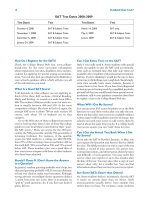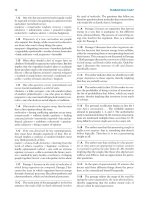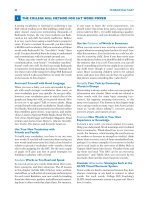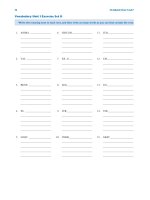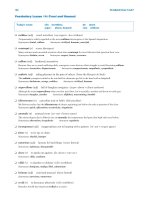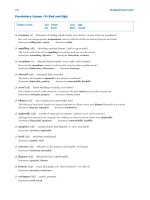Sat - MC Grawhill part 8 ppsx
Bạn đang xem bản rút gọn của tài liệu. Xem và tải ngay bản đầy đủ của tài liệu tại đây (195.46 KB, 10 trang )
9 9 999 9
GO ON TO THE NEXT PAGE
3. The airline industry has adopted new pricing
procedures; seeming to benefi
t both the con-
sumers as well as the companies.
(A) procedures; seeming to benefit both the
consumers as well as
(B) procedures; seemingly benefitting both
the consumers and
(C) procedures seemingly in benefit of both
the consumers as well as
(D) procedures that seem benefitting of both
the consumers and
(E) procedures that seem to benefit both the
consumers and
4. The thirty-foot-high stone wall, built over the
course of eighty years, once protecting the city
from invaders.
(A) wall, built over the course of eighty
years, once protecting
(B) wall, built over the course of eighty years,
once protected
(C) wall was built over the course of eighty
years, which protected
(D) wall was built over the course of eighty
years in protecting
(E) wall, built over the course of eighty
years; it once protected
5. A concise and informative guide for writers,
William Zinsser’s
On Writing Well has sold
nearly one million copies.
(A) William Zinsser’s On Writing Well has
sold nearly one million copies
(B) nearly one million copies of William
Zinsser’s On Writing Well have been sold
(C) William Zinsser wrote On Writing Well,
which has sold nearly one million copies
(D) William Zinsser’s On Writing Well
having sold nearly one million copies
(E) On Writing Well has sold nearly one
million copies by William Zinsser
6. When you submit personal information to a
Web site, one should make sure
that it won’t be
used for unauthorized purposes.
(A) one should make sure
(B) and make sure
(C) then make sure
(D) be sure of
(E) make sure
7. Although passenger pigeons once filled the skies
over Michigan, relentless hunting eliminated
their entire population by 1901.
(A) relentless hunting eliminated their entire
population by 1901
(B) it was relentless hunting eliminating
their entire population by 1901
(C) its entire population was eliminated by
relentless hunting by 1901
(D) by 1901 it was relentless hunting
eliminating their entire population
(E) relentless hunting having eliminated
their entire population by 1901
8. The failure of the relief effort was more a result
of poor coordination than because of blatant
corruption.
(A) poor coordination than because of
blatant corruption
(B) coordination being poor than by
blatant corruption
(C) poor coordination than by blatant
corruption
(D) poor coordination than of blatant
corruption
(E) coordination being poor than corruption
being blatant
60 McGRAW-HILL’S SAT
CHAPTER 2 / DIAGNOSTIC SAT 61
9 9 999 9
9. Until revealing that she had been working at a
design firm, few of her friends realized that
Amanda was interested in art.
(A) Until revealing that she had been
working
(B) Having revealed that she had been
working
(C) Until she revealed that she had been
working
(D) Being that she revealed she had worked
(E) Until she revealed about her working
10. Inspired by reading about the great explorers,
it was Gerald’s decision to sail around the
world.
(A) it was Gerald’s decision to sail around
the world
(B) Gerald decided to sail around the world
(C) the decision was made by Gerald to sail
around the world
(D) sailing around the world was what
Gerald decided to do
(E) Gerald having decided to sail around the
world
11. The results of the election were so close that
the club had it decided that they would have
co-presidents.
(A) had it decided that they would have
co-presidents
(B) decided to have co-presidents
(C) would have decided to have
co-presidents
(D) decided they would have co-presidents
(E) had decided that they would have
co-presidents
12. Writing skills are waning because the wide-
spread use of e-mail and instant messaging dis
-
courages students from developing their ideas
and supporting those ideas logically.
(A) messaging discourages students from
developing their ideas and supporting
(B) messaging discourage students to
develop their ideas and support
(C) messaging, which discourages students
from developing their ideas and
supporting
(D) messaging discouraging students from
developing their ideas and supporting
(E) messaging discouraging students to
develop their ideas and support
13. To acknowledge
opposing viewpoints does not
mean subverting your own thesis, and in fact
usually creates a more cogent essay.
(A) To acknowledge
(B) In acknowledging
(C) Acknowledging
(D) While acknowledging
(E) For the acknowledgment of
14. To get the full benefit of any medication, avoid
problems, and for the reduction of possible
side effects, discuss your prescription with
your doctor.
(A) for the reduction of possible side effects
(B) for reducing possible side effects
(C) reducing possible side effects
(D) also to reduce possible side effects
(E) reduce possible side effects
STOP
If you finish before time is called, you may
check your work on this section only. Do not
turn to any other section of the test.
62 McGRAW-HILL’S SAT
ANSWER KEY
Critical Reading
Section 3 Section 6 Section 8
COR. DIFF.
ANS. LEV.
1. A1
2. D1
3. C2
4. B3
5. D4
6. E4
7. A4
8. C5
9. C2
10. C3
11. A3
12. D4
COR. DIFF.
ANS. LEV.
13. C2
14. B3
15. E3
16. B4
17. A4
18. C3
19. B3
20. C4
21. B3
22. D2
23. A3
24. E5
COR. DIFF.
ANS. LEV.
1. B2
2. C2
3. A3
4. C3
5. D4
6. C3
7. A3
8. C2
9. C3
10. B2
11. C4
12. B5
COR. DIFF.
ANS. LEV.
13. C3
14. B4
15. E3
16. C4
17. B4
18. E5
19. C3
20. A3
21. E4
22. A3
23. C4
24. B4
COR.
DIFF.
ANS. LEV.
1. D1
2. C2
3. D3
4. A4
5. E5
6. C5
7. C2
8. B4
9. E4
10. A3
COR. DIFF.
ANS. LEV.
11. D4
12. A2
13. C2
14. C4
15. B4
16. A3
17. A3
18. C3
19. B4
COR. DIFF.
ANS. LEV.
1. C1
2. E1
3. D3
4. E2
5. B2
6. A2
7. D3
8. C2
9. B3
10. A3
COR. DIFF.
ANS. LEV.
11. A3
12. B3
13. D3
14. B4
15. D3
16. C4
17. C4
18. D4
19. D5
20. E5
COR. DIFF.
ANS. LEV.
1. B1
2. D2
3. C3
4. C3
5. D3
6. A4
7. C4
8. B5
COR.
DIFF.
ANS. LEV.
9. 0.4 1
10. .333 or 1/3 2
11. 30 3
12. 60 3
13. 28 3
14. 64
15. 81 3
16. 10 4
17. 2.5 4
18. 45
COR. DIFF.
ANS. LEV.
1. C2
2. D2
3. C2
4. B3
5. A3
6. B3
7. D3
8. A3
COR. DIFF.
ANS. LEV.
9. D4
10. B4
11. E3
12. B4
13. E3
14. C4
15. D5
16. B5
NOTE: Difficulty levels are estimates of question difficulty that range from 1 (easiest) to 5 (hardest).
Math
Section 2 Section 5 Section 7
Multiple-Choice
Student-produced
Questions
Response questions
Writing
Section 4 Section 9
COR. DIFF.
ANS. LEV.
1. B1
2. E1
3. D2
4. C3
5. C4
6. D2
7. A3
8. D4
9. B4
10. E3
COR. DIFF.
ANS. LEV.
11. D4
12. B1
13. C1
14. B2
15. E3
16. C3
17. C2
18. C3
19. B3
20. B3
COR. DIFF.
ANS. LEV.
21. B3
22. D4
23. D3
24. B4
25. D3
26. B3
27. B4
28. E4
29. A5
30. B3
COR. DIFF.
ANS. LEV.
31. A3
32. E3
33. A3
34. D3
35. C3
COR. DIFF.
ANS. LEV.
1. C1
2. E2
3. E2
4. B2
5. A2
6. E2
7. A3
8. D3
9. C3
10. B3
COR. DIFF.
ANS. LEV.
11. B3
12. A4
13. C4
14. E3
Number correct
Number incorrect
Number correct
Number incorrect
Number correct
Number incorrect
Number correct
Number incorrect
Number correct
Number incorrect
Number correct
(9–18)
Number correct
Number incorrect
Number correct
Number incorrect
Number correct
Number incorrect
CHAPTER 2 / DIAGNOSTIC SAT 63
SCORE CONVERSION TABLE
How to score your test
Use the answer key on the previous page to determine your raw score on each section. Your raw score
on each section except Section 5 is simply the number of correct answers minus
1
⁄
4
of the number
of wrong answers. On Section 5, your raw score is the sum of the number of correct answers for
questions 1–8 minus
1
⁄
4
of the number of wrong answers for questions 1–8 plus the total number of
correct answers for questions 9–18. Next, add the raw scores from Sections 3, 6, and 8 to get your Critical
Reading raw score, add the raw scores from Sections 2, 5, and 7 to get your Math raw score, and add the
raw scores from Sections 4 and 9 to get your Writing raw score. Write the three raw scores here:
Raw Critical Reading score: ____________ Raw Math score: ____________ Raw Writing score: ___________
Use the table below to convert these to scaled scores.
Scaled scores: Critical Reading: _____________ Math: _____________ Writing: _____________
Critical Critical
Reading Math Writing Reading Math Writing
Raw Scaled Scaled Scaled Raw Scaled Scaled Scaled
Score Score Score Score Score Score Score Score
67 800 32 520 570 610
66 800 31 510 560 600
65 790 30 510 550 580
64 780 29 500 540 570
63 770 28 490 530 560
62 750 27 490 520 550
61 740 26 480 510 540
60 730 25 480 500 530
59 720 24 470 490 520
58 700 23 460 480 510
57 690 22 460 480 500
56 680 21 450 470 490
55 670 20 440 460 480
54 660 800 19 440 450 470
53 650 800 18 430 450 460
52 650 780 17 420 440 450
51 640 760 16 420 430 440
50 630 740 15 410 420 440
49 620 730 800 14 400 410 430
48 620 710 800 13 400 410 420
47 610 710 800 12 390 400 410
46 600 700 790 11 380 390 400
45 600 690 780 10 370 380 390
44 590 680 760 9 360 370 380
43 590 670 740 8 350 360 380
42 580 660 730 7 340 350 370
41 570 650 710 6 330 340 360
40 570 640 700 5 320 330 350
39 560 630 690 4 310 320 340
38 550 620 670 3 300 310 320
37 550 620 660 2 280 290 310
36 540 610 650 1 270 280 300
35 540 600 640 0 250 260 280
34 530 590 630 −1 230 240 270
33 520 580 620 −2 or less 210 220 250
64 McGRAW-HILL’S SAT
SCORE CONVERSION TABLE FOR WRITING COMPOSITE
[ESSAY + MULTIPLE CHOICE]
Calculate your writing raw score as you did on the previous page, and grade your essay from a 1 to a 6
according to the standards that follow in the detailed answer key.
Essay score: ____________ Raw Writing score: ____________
Use the table below to convert these to scaled scores.
Scaled score: Writing: _____________
Raw Essay Essay Essay Essay Essay Essay Essay
Score Score 0 Score 1 Score 2 Score 3 Score 4 Score 5 Score 6
–2 or less 200 230 250 280 310 340 370
–1 210 240 260 290 320 360 380
0 230 260 280 300 340 370 400
1 240 270 290 320 350 380 410
2 250 280 300 330 360 390 420
3 260 290 310 340 370 400 430
4 270 300 320 350 380 410 440
5 280 310 330 360 390 420 450
6 290 320 340 360 400 430 460
7 290 330 340 370 410 440 470
8 300 330 350 380 410 450 470
9 310 340 360 390 420 450 480
10 320 350 370 390 430 460 490
11 320 360 370 400 440 470 500
12 330 360 380 410 440 470 500
13 340 370 390 420 450 480 510
14 350 380 390 420 460 490 520
15 350 380 400 430 460 500 530
16 360 390 410 440 470 500 530
17 370 400 420 440 480 510 540
18 380 410 420 450 490 520 550
19 380 410 430 460 490 530 560
20 390 420 440 470 500 530 560
21 400 430 450 480 510 540 570
22 410 440 460 480 520 550 580
23 420 450 470 490 530 560 590
24 420 460 470 500 540 570 600
25 430 460 480 510 540 580 610
26 440 470 490 520 550 590 610
27 450 480 500 530 560 590 620
28 460 490 510 540 570 600 630
29 470 500 520 550 580 610 640
30 480 510 530 560 590 620 650
31 490 520 540 560 600 630 660
32 500 530 550 570 610 640 670
33 510 540 550 580 620 650 680
34 510 550 560 590 630 660 690
35 520 560 570 600 640 670 700
36 530 560 580 610 650 680 710
37 540 570 590 620 660 690 720
38 550 580 600 630 670 700 730
39 560 600 610 640 680 710 740
40 580 610 620 650 690 720 750
41 590 620 640 660 700 730 760
42 600 630 650 680 710 740 770
43 610 640 660 690 720 750 780
44 620 660 670 700 740 770 800
45 640 670 690 720 750 780 800
46 650 690 700 730 770 800 800
47 670 700 720 750 780 800 800
48 680 720 730 760 800 800 800
49 680 720 730 760 800 800 800
CHAPTER 2 / DIAGNOSTIC SAT 65
College Hill™ SAT Study Plan
See page 2–4 for instructions.
Test # ________ RAW SCORES: CR _________ M _________ W _________ Essay _________
SCALED SCORES: CR _________ M _________ W _________ Essay _________
1. What were your test conditions?
2. What was your pre-test routine?
Goal Attack
M pts
CR pts
W pts
500 75% 50% 30 25 22
550 80% 60% 37 32 27
600 85% 67% 45 38 31
650 90% 80% 52 44 36
700 100% 90% 59 49 40
750 100% 95% 62 52 44
800 100% 100% 66 54 47
3. Did you attack all of the questions you needed to attack? (See the table above.)
4. Did you rush to complete any section?
5. How many more
raw
points do you need to make your score goal? CR _______ M _______ W _______
6. Did you make educated guesses on any questions? If so, how many points did you pick up on these questions?
7. STUDY PLAN: Use the detailed answer key after the test to review the answers to the questions you missed.
Below, list the lessons linked to the questions you missed, and list the tough words you missed from the test.
Lessons to Review Words to Review
___________________________________________ _____________________________________________
___________________________________________ _____________________________________________
___________________________________________ _____________________________________________
___________________________________________ _____________________________________________
___________________________________________ _____________________________________________
___________________________________________ _____________________________________________
___________________________________________ _____________________________________________
___________________________________________ _____________________________________________
Get
66 McGRAW-HILL’S SAT
Detailed Answer Key
The creature that Victor Frankenstein created was
horrible to all who saw it, including Victor himself.
Huge, misshapen and awkward, the creature was not
even considered human. Indeed, the creature began
to fulfill the only role that humans allowed him to oc-
cupy: the role of a bloodthirsty monster. Yet what
Mary Shelley’s Frankenstein shows us is not so much
how rare and horrible it is to alter the natural order,
but how tragically simple it is to create a monster.
Victor Frankenstein created a monster not by contra-
vening nature, as many would believe, but by judging
the creature by his outward appearance and treating
him like an unworthy freak.
How simple it is to hate others, to consider them
less than human, based on superficial analysis. Ha-
tred is the desperate accomplice of fear. In recent
years, too many of us Americans—denizens of the
land of the free and home of the brave—have become
imprisoned by our hatred and cowed by our fear of
the unknown. Our leaders are too often complicit in
rousing this fear and fueling this hate, and in mistak-
ing a quick trigger finger for bravery in the face of
threat. They become quick to imprison or kill people
who scare us at first, rather than acknowledge that
they are humans with rights. They see the populace
cringing at foreigners because foreigners attacked us
in 2001. They can’t see past their irrational fear to the
enormous need to reach out to disenfranchised and
subjugated cultures and listen to their concerns. If
only Victor Frankenstein had tried to learn what his
creature would need once it was given life.
Our leaders are often the blindest of all because,
to survive, they must not edify but pander. They see
the populace cringing in fear at the prospect of human
cloning because they imagine Frankenstein’s mon-
ster. They can’t see past their irrational fear to the
huge potential medical benefits of stem cell research.
They refuse to see that clones are indistinguishable
from twins, and that twins are not horrible mon-
strosities. We can’t really expect politicians or the
media—who pander to popularity polls and big cor-
porate donations—to see the world for what it truly
is. They judge the world book by its cover, as did the
angry villagers of Ingolstadt.
Our current situation will get better only once a
critical mass of the American population begins to see
that we are creating monsters everywhere by our
irrational fear of the new and the foreign. We value
instant polls of superficial and uninformed opinions
more than careful thought and deep analysis. Perhaps
it’s time to open the book and read it carefully rather
than just glancing at the cover.
Section 1
Consider carefully the issue discussed in the following passage, then write an essay that answers the ques-
tion posed in the assignment.
In a culture obsessed with superficial appearances, our leaders should be those who can
see beyond the surface. Judging a book by its cover is the job of the plebeian or the con-
sumer, but reading the book—pondering its contents and perhaps seeking to write new
chapters—is the job of a leader.
Assignment: How important is it to look beyond superficial appearances? Write an essay in
which you answer this question and discuss your point of view on this issue. Support
your position logically with examples from literature, the arts, history, politics, science
and technology, current events, or your experience or observation.
The following essay received 6 points out of a possible 6, meaning that it demonstrates clear and consis-
tent competence in that it
• develops an insightful point of view on the topic
• demonstrates exemplary critical thinking
• uses effective examples, reasons, and other evidence to support its thesis
• is consistently focused, coherent, and well organized
• demonstrates skillful and effective use of language and sentence structure
• is largely (but not necessarily completely) free of grammatical and usage errors
CHAPTER 2 / DIAGNOSTIC SAT 67
The following essay received 4 points out of a possible 6, meaning that it demonstrates adequate compe-
tence in that it
• develops a point of view on the topic
• demonstrates some critical thinking, but perhaps not consistently
• uses some examples, reasons, and other evidence to support its thesis, but perhaps not adequately
• shows a general organization and focus, but shows occasional lapses in this regard
• demonstrates adequate but occasionally inconsistent facility with language
• contains occasional errors in grammar, usage, and mechanics
Whoever said you can’t judge a book by its cover
probably never had to drive on the highway behind a
Hummer. Americans are obsessed with making a first
impression, usually an impression of aggression and
wealth. Certainly, first impressions about human be-
ings are usually wrong, but American culture is, un-
fortunately, being increasingly defined by consumer
items that give an aggressive first impression and last
impression. These items, unlike human beings, are
designed carefully, and their first impressions are in-
tended to convey the entire product.
A good example of this is the Super Bowl. It has
become a flashy, decadent display of consumption
rather than what it should be, a display of athletic
prowess. Our obsession with consumer goods that
make us seem more attractive or stronger and more
powerful have made it clear that we’re not concerned
with substance as much as appearances. Every com-
mercial shouts at you that first appearances are every-
thing. Our schools are filled with people who think
that the most important things in their lives are what
shoes they wear or what cell phone they use.
Popular psychologists like Dr. Phil appear on tele-
vision and tell us how important it is for us to be our-
selves and not let other people tell us who we are, and
then a string of commercials comes on telling you
how a beer or car or deodorant makes you look more
attractive. Which message do we really hear?
The following essay received 2 points out of a possible 6, meaning that it demonstrates some incompe-
tence in that it
• has a seriously limited point of view
• demonstrates weak critical thinking
• uses inappropriate or insufficient examples, reasons, and other evidence to support its thesis
• is poorly focused and organized and has serious problems with coherence
• demonstrates frequent problems with language and sentence structure
• contains errors in grammar and usage that seriously obscure the author’s meaning
I think that definitely you can’t judge a book by its
cover. Like my friend Cal is a really good wrestler and
he even got into the state finals for his weight class.
Everybody thinks he’s a total jock but not a lot of peo-
ple know also that he works really hard every day
after practice at his uncle’s garage and a lot of people
think he’s as good as a lot of other mechanics. He’s a
lot smarter than people give him credit for and he
get’s really good grades in math.
As a matter of fact he’s in the honors level of
math and will probably take calculus next year, so
he’s not just a jock or even just a great mechanic.
When you look at him, especially when he’s got his
game face on just before a match, you would hardly
believe that he could be a good student.
The next time you see an athlete, don’t assume
that he is just a dumb jock. Professional athletes
have sometimes become senators and business
leaders, so sometimes they have minds as well as
muscles.
68 McGRAW-HILL’S SAT
80° 100°
m
80°
80°
80°
100°
100°
100°
l
Section 2
1. C Substitute k = 10 into 2m + k = 12 to get
2m + 10 = 12
Subtract 10: 2m = 2
Divide by 2: m = 1
(Chapter 8, Lesson 1: Solving Equations)
2. E If the average of three numbers is 50, then
their sum must be 3(50) = 150. If two of the numbers
are 35 and 50, then the third is 150 − 35 − 50 = 65
(Chapter 9, Lesson 2: Mean/Median/Mode Problems)
3. D Since the ones column has only one A, it is
easy to figure out its value from there. The only value
for A that yields a 7 in the ones column is 4.
(Chapter 9, Lesson 3: Numerical Reasoning Problems)
4. E The problem is best solved with a proportion:
. Cross-multiply: 25x = 2025
Divide by 25: x = 81
(Chapter 7, Lesson 4: Ratios and Proportions)
5. B Since 32 = 2
5
, we can substitute: 2
x−1
= 32
2
x−1
= 2
5
x − 1 = 5
Add 1: x = 6
(Chapter 8, Lesson 3: Working with Exponents)
6. A Since there were 59 yes votes, 26 of which were
from men, 59 − 26 = 33 of them were from women.
Since there were 76 women in total, 33 of whom voted
yes, 76 − 33 = 43 of them must have voted no.
(Chapter 11, Lesson 5: Data Analysis)
7. D They both start with x cards. After Mike gives
Kenny 12 cards, Mike has x − 12 and Kenny has x + 12
cards. If Kenny has twice as many as Mike, then
x + 12 = 2(x − 12)
Distribute: x + 12 = 2x − 24
Add 24: x + 36 = 2x
Subtract x: 36 = x
Since they each had 36 cards to start, they had a total
of 36 + 36 = 72.
(Chapter 8, Lesson 7: Word Problems)
8. C The fraction that is walnuts equals the amount
of walnuts divided by the total amount:
Simplify:
(Chapter 7, Lesson 4: Ratios and Proportions)
x
x()+ 35
x
x()++15 20
9
25 225
=
x
9. B You might simplify this problem by plugging
in possible values for the angle measures, remember-
ing the parallel lines theorem. Your diagram might
look like this:
This example shows that a + d + f + g = 360°, and the
only other sum among the choices that equals 360°
is (B).
(Chapter 10, Lesson 1: Lines and Angles)
10. A Either plug in the ordered pairs to check, or
draw a graph, as long as you can do it quickly. Notice
that the point (7, −1) satisfies both inequalities:
2(7) + 3(−1) > 6 and 7 − (−1) > 6.
(Chapter 8, Lesson 6: Inequalities, Absolute Value,
and Plugging In)
11. A If n has a remainder of 6 when it is divided by
12, it must be 6 more than a multiple of 12. Pick any
one you like: 18, for example. When 18 is divided by
6, the remainder is 0.
(Chapter 7, Lesson 7: Divisibility)
12. B Any five-sided polygon can be divided into
three triangles like so:
Since the sum of the angles in a triangle is 180°, the sum
of the angles in this figure is 3(180) = 540°. The average
measure of the five angles, then, is 540/5 = 108°.
(Chapter 10, Lesson 2: Triangles)
CHAPTER 2 / DIAGNOSTIC SAT 69
18. D Think about how many options you have to fill
each place, from left to right. Since the first person
must be a girl, you have 6 options. Since the next must
be a boy, you have 5 options. Since the next must be a
boy, you have 4 options (one is already up there). Since
the next must be a girl, you have 5 options left. This
means that the total number of possible arrangements
is (6)(5)(4)(5) = 600.
(Chapter 9, Lesson 5: Counting Problems)
19. D If the two lines are parallel, then they have the
same slope. The slope of l is , so the slope of m
must be
Cross-multiply: 3k = 48
Divide by 3: k = 16
Therefore, the rectangle has a width of 16 and a
height of 12, so its area is (16)(12) = 192.
(Chapter 10, Lesson 4: Coordinate Geometry)
20. E If v is the volume of the solid, then abc = v.
Solving this equation for a gives , so statement
II must be true. Now go to the answer choices, and
notice that you can eliminate any choice without II,
namely (A) and (C). Also notice from the original
equation that v could not be odd if any of the integers
a, b, or c were even, therefore they must all be odd.
This implies that a + b + c is odd, so statement I must be
true. This eliminates choice (D). To check statement
III, you need an expression for the surface area of the
solid, which is 2(ab) + 2(bc) + 2(ac) = 2(ab + bc + ac).
Since this is a multiple of 2, it is even, so statement III
is also true.
(Chapter 9, Lesson 3: Numerical Reasoning Problems)
(Chapter 10, Lesson 7: Volumes and 3-D Geometry)
a
v
bc
=
3
4
12 3
4
as well. Therefore
k
=
9
12
3
4
=
To find the area of the triangle, you need to use the
formula area = base × height/2. Since the height di-
vides the triangle into two 30°−60°−90° triangles,
the other sides have lengths shown. The base of the
triangle is and the height is 3, so the area is
(Chapter 10, Lesson 3: The Pythagorean Theorem)
15. D The sum of the parts is 4 + 3 + 2 + 1 = 10.
Therefore, the parts are of the
whole. The largest share, then, is ($50,000)(4/10) =
$20,000.
(Chapter 7, Lesson 4: Ratios & Proportions)
16. C Use the definition to translate the equation:
m{n} = 9
Translate: m
2
/n
2
= 9
Now think about what values of m and n will
work. Notice that 3 and 1 will work, but so will −3
and −1. Now plug these into the statements, and see
if any are false. Since −3 is not greater than −1,
statement I can be eliminated, and so can answers
(B), (D), and (E). Notice that this means you don’t
have to check statement II, because it’s in both
remaining answers. Statement III must be true
because if , then must equal 3 or –3.
Therefore, equals 1 or –1, so it is an integer.
(Chapter 6, Lesson 7: Thinking Logically and Checking)
(Chapter 9, Lesson 1: New Symbol or Term Problems)
17. C Let’s say there are x blue marbles in the jar. This
means there are 3x white marbles, and 2(3x) = 6x red
marbles, for a total of 10x marbles. Since 3x are white,
the probability of picking a white is 3x/10x = 3/10.
(Chapter 9, Lesson 6: Probability Problems)
m
n3
m
n
m
n
2
2
9=
4
10
32
,
10
,
10
,and
1
10
633
2
93.
(
)
(
)
=
63()
Section 3
1. A The fact that they rarely agreed implies that
their opinions would often differ.
diverge = differ or move apart; coincide = fit together
or occur simultaneously; retreat = move away; assem-
ble = put together; truncate = cut short
2. D The sentence implies a contrast between what
once was and what is now. If it is no longer an incon-
trovertible (irrefutable) truth, it must now be in doubt.
enacted = put into effect officially; irrefutable =
impossible to disprove; universal = true at all places
and times; dubious = doubtful; conclusive = acting as
final proof
13. D Remember that the word “is” can be inter-
preted as the equals sign (=). Therefore, “The number
of dogs is 3 fewer than 4 times the number of cats”
can be translated into d = 4c − 3.
(Chapter 8, Lesson 7: Word Problems)
14. B Mark up the diagram with the information
given:
3√3
30°
P
6
R
6
30°
S
60° 60°
3
3√3


